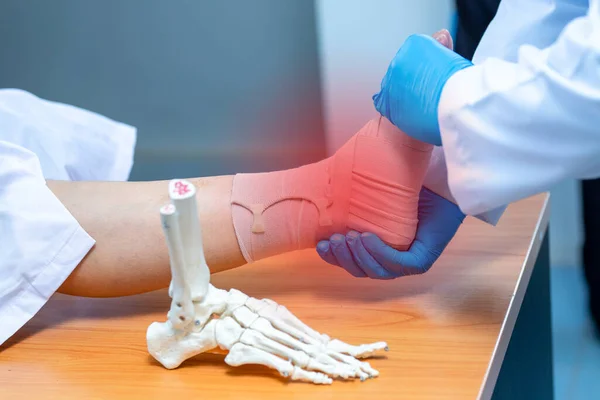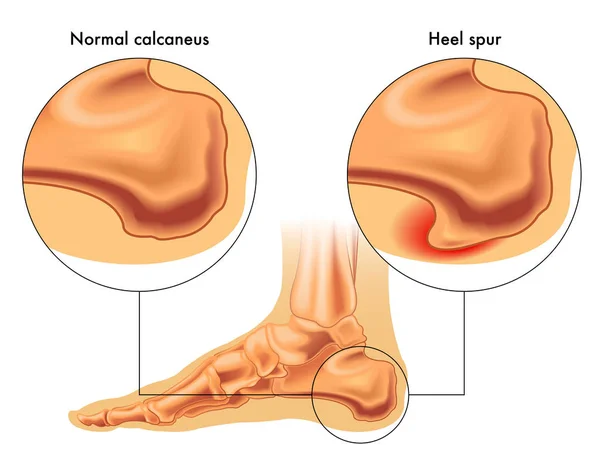Heel spurs are a common issue, and while typically occurring in one foot, they can sometimes develop in both. Fortunately, various treatments can alleviate the pain associated with heel spurs. If you’re experiencing persistent heel pain, you might be dealing with a heel spur. We connected with experts to learn more about what heel spur pain is, what causes it, and how to ease the ache.

What is a Heel Spur?
A heel spur is a bony projection that develops on the underside of the heel bone. It occurs when calcium deposits accumulate between the heel and the arch of your foot, hardening over several months into a protrusion. These spurs can vary in shape, appearing as point-like or hook-shaped, and may extend from the heel towards the mid-foot.
Think of these formations as small calcium deposits that build up over time at the point where the heel bone meets the arch of the foot, according to Gregory Alvarez, DPM, FACFAS, a board-certified podiatrist at Ankle & Foot Centers of America.
These bony growths affect around 15 percent of people and usually measure less than half an inch long. Their unique hook-like shape and location near the heel are what gives them their name.

Sometimes, heel spurs are associated with plantar fasciitis, which involves inflammation of the plantar fascia. The plantar fascia is a thick ligament that connects the heel to the front of the foot, supporting the arch and facilitating smooth movement.
Risk Factors for Heel Spurs
Several factors can increase your risk of developing heel spurs:
- Walking gait abnormalities Gait issues can place excessive stress on the heel bone, ligaments, and nerves.
- High-impact activities Running or jogging, especially on hard surfaces, can contribute to heel spurs.
- Improper footwear Shoes that are poorly fitted or lack adequate arch support can increase the risk.
- Excess weight Obesity and being overweight place additional stress on the feet.
- Underlying conditions Certain conditions like inflammatory arthritis can contribute to heel spur development.
- Wear and tear Long-term wear and tear of the foot’s muscles and ligaments can cause damage.
What Heel Spur Pain Feels Like
The hallmark symptom of a heel spur is a sharp, stabbing pain in the heel. However, some people might experience it as a dull ache or burning sensation. The pain is typically more intense in the morning when taking the first steps or after prolonged sitting, and it may decrease throughout the day. The pain may worsen after exercise or prolonged standing. Keep in mind that many heel spurs are asymptomatic.
How to Treat Heel Spur Pain
While heel spurs are permanent once formed, the pain can be managed effectively with various home remedies:
- Rest: Reduce activities that put stress on your heel10. Resting your foot, especially after long periods of standing, can prevent the condition from worsening.
- Ice: Apply a cold compress to the affected area to relieve inflammation. Cold therapy can help to relieve inflamed heel tissue.
- Proper footwear: Wear shoes with good arch support and cushioning. Orthotic shoe inserts, like heel pads, provide arch and heel support to reduce pain and prevent further wear and tear.
- Medications: Over-the-counter pain relievers like NSAIDs can help manage pain and reduce swelling.
- Stretching: Regular stretching exercises can alleviate pain associated with tight muscles and connective tissues in the foot and lower leg.
Practice Strengthening Exercises
Foot-strengthening and stretching exercises can provide relief. Physical therapy can be beneficial, and a physical therapist can show you how to do some of the exercises at home. Heel spur exercises consist of stretching the heel and plantar fascia muscles.
What to Do If Home Remedies Don’t Provide Relief
If your heel pain persists despite trying home remedies, it’s time to consult a healthcare provider. They can properly diagnose your condition and recommend further treatment options, such as:
- Physical therapy: A physical therapist can guide you through specific exercises and techniques to strengthen your foot and alleviate pain.
- Injections: Corticosteroid injections can reduce inflammation and provide temporary pain relief.
- Orthotics: Custom-made orthotic devices can provide better support and cushioning for your feet.
- Surgery: In rare cases, surgery may be necessary to remove the heel spur or release the plantar fascia.
Instant Foot Pain Relief! 5 Exercises To Fix Your Plantar Fasciitis
Also Read | Frozen Shoulder Relief: How to Ease Pain During Perimenopause






